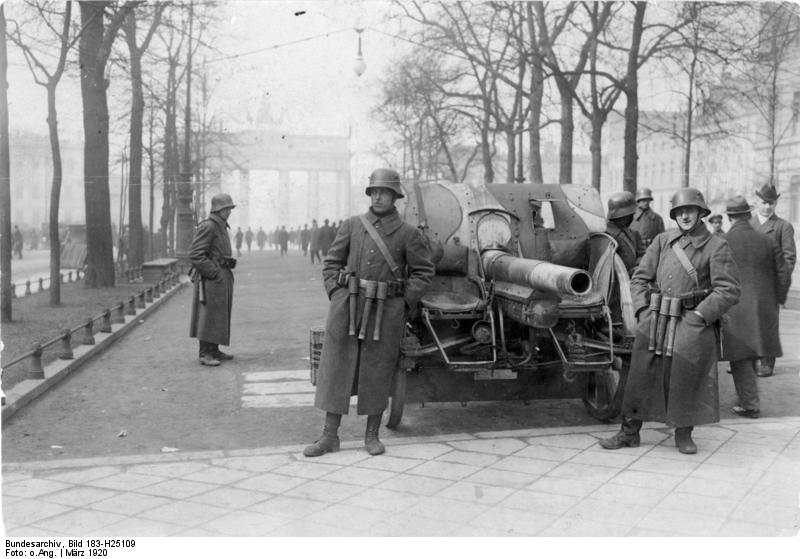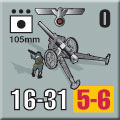The Book of Armaments:
Germany’s Light Field Howitzer
by Mike Bennighof, Ph.D.
October 2020
 The Treaty of Versailles restricted Germany to artillery of no greater caliber than 105mm, and only 84 of those - a dozen pieces for each of the permitted seven infantry divisions, with no spares. The standard German light howitzer at the end of the Great War, the leFH16, reached the front-line batteries in early 1917 with just over 3,000 of them built. All remaining pieces beyond those 84 tubes were to be confiscated by the victorious Allies. The Treaty of Versailles restricted Germany to artillery of no greater caliber than 105mm, and only 84 of those - a dozen pieces for each of the permitted seven infantry divisions, with no spares. The standard German light howitzer at the end of the Great War, the leFH16, reached the front-line batteries in early 1917 with just over 3,000 of them built. All remaining pieces beyond those 84 tubes were to be confiscated by the victorious Allies.
After the war, the Weimar Republic’s Reichswehr adopted the 75mm FK 16na, a rebuilt version of the wartime 77mm FK16, as its standard divisional gun, with the 105mm leFH16 as its divisional howitzer. As the 1920’s wore on, the weapons began to show their age and the Reichswehr held a series of trials to selected successors to them. The Inter-Allied Control Commission had disbanded and French occupation troops had left the Ruhr industrial region in 1926, and in 1927 Krupp re-established its forbidden artillery design bureau.

The German Navy’s Ehrhardt Brigade poses with an leFH16 on Under den Linden, 1920.
Rheinische Metallwaren und Maschinenfabrik (Rheinmetall) provided a new model of their 75mm field gun, and a proposed design for a modern 105mm howitzer. Under the 1927 syndicate arrangement dictated by the Defense Ministry, Rheinmetall had become the exclusive supplier for weapons up to 170mm caliber, and Krupp for those larger than that bore - weapons specifically forbidden to Germany by the Versailles Treaty. But Krupp could, and did, participate in design work, forming a secret partnership with the Swedish firm of Bofors to try out new ideas in the Bofors 105mm Model 1927 cannon.
The Reichswehr generals decided to pass on the new 75mm FK18 field gun, a Krupp design, though in good German fashion they approved production of a small number anyway for the cavalry divisions. After the lifting of treaty limits and cancellation of the syndicate Krupp produced a far superior model, the FK38, for export to Brazil, raising the question of whether an inferior cannon was entered into the competition to push the generals toward a bigger weapon.
Instead of adopting a light field gun like every other European army, the Reichswehr decided to rely on the 105mm howitzer as their standard divisional light artillery piece, and replace the battalion of 105mm howitzers in each divisional artillery regiment with one of 150mm pieces, which had already proven extremely effective during the Great War.
That decision would have a profound impact on German combat effectiveness during the first years of the war. A German infantry division went into battle with enormously greater artillery firepower than a corresponding Polish, French, British or Soviet formation; not until the Germans met the Americans, with a better 105mm howitzer and seemingly endless supplies of ammunition, would they be out-artilleried.

The wooden platform will prevent this leFH18 from sinking into the mud.
A secret purchase order directed Rheinmetall and Krupp to proceed with development of the new leFH (light field howitzer) 18 to replace the leFH16, and the project began in earnest in 1929. The new howitzer drew heavily on both the leFH16 and FK18 designs as well as the Model 1927, following a fairly standard design but adding a split-trail carriage that offered a stable gunnery platform.
The longer barrel and improved breech increased the weapon’s range by about a kilometer and a half, to 10,600 meters. Its explosive charge, usually TNT, was about 25 percent larger than the older weapon’s. Accuracy was very good, and crews found the howitzer very easy to handle. It was provided with a wide array of shell types including an unusual dedicated leaflet-launching round. The new howitzer could use the old model’s ammunition, and it turned out that it could also accommodate several types of captured French rounds.
Design work on the leFH18 had been completed by late 1930, but the project remained in limbo as Germany’s re-armament had to remain a secret. That came to a rapid close in 1933, with Adolf Hitler taking power and directing the Reichswehr to enact its long-held expansion plans. The seven infantry divisions became 21, now each to be armed with 36 105mm howitzers instead of a dozen. Suddenly, the Reichswehr began to miraculously “discover” stockpiles of leFH16 howitzers buried under piles of debris, or dis-assembled in spare parts depots. From the 84 pieces allowed by the Versailles Treaty, the inventory grew to 496 howitzers in 1934, 568 of them in 1935, 728 howitzers in 1936 and finally 980 of them in 1937.
In 1935 Hitler ended the secrecy and openly declared German re-armament, ordering the Reichswehr, now re-named the Wehrmacht, to expand to 35 regular infantry divisions. That actually displeased the generals, who did not yet have the weapons to arm all of those new formations - they now needed 1,260 light howitzers. Amid the blizzard of announcements of new weapons entering production - previously-forbidden tanks, submarines and aircraft - was the order for Rheinmetall to begin series production of the leFH18 light field howitzer.

An leFH18 fires at Stalingrad, 1942.
The first new howitzers reached the troops in 1937, with 4,862 of them delivered before the invasion of Poland commenced. The older leFH16 fell out of front-line use as the new weapons arrived, first shifting to second-line units and later to fixed defenses in France and Norway. Another 6,933 howitzers were produced during the course of the war, with production continuing until Germany surrendered.
The front-line batteries asked for a lighter version of the leFH18, and in March 1943 they took delivery of the leFH18/40, the same tube mounted on a modified version of the 75mm PAK40 anti-tank gun’s carriage. Another 10,245 of this model were delivered, and including variants built for use on self-propelled mounted the weapon’s total production reached 23,966. Export customers include Spain, Finland and Romania.
While the leFH18 was superior to its European equivalents, it was outclassed by the Soviet M1938 122mm howitzer, which boasted a greater range and much heavier explosive charge, and the American M2A1 105mm howitzer, which had greater range and a slightly more powerful charge. American artillery of all types became far more capable when the VT proximity fuze was unveiled in late 1944.
 Far more than the weapon itself, the German decision to make it the standard weapon of their divisional artillery regiments gave them an enormous edge in the early campaigns of World War II. The leFH18 was a very solid weapon, but its deployment in huge numbers proved decisive. It appears in every Panzer Grenadier game featuring German forces, usually both as a playing piece and as off-board artillery, and of course in The Book of Armaments. Far more than the weapon itself, the German decision to make it the standard weapon of their divisional artillery regiments gave them an enormous edge in the early campaigns of World War II. The leFH18 was a very solid weapon, but its deployment in huge numbers proved decisive. It appears in every Panzer Grenadier game featuring German forces, usually both as a playing piece and as off-board artillery, and of course in The Book of Armaments.
You can order The Book of Armaments: Eastern Front Artillery right here.
Sign up for our newsletter right here. Your info will never be sold or transferred; we'll just use it to update you on new games and new offers.
Mike Bennighof is president of Avalanche Press and holds a doctorate in history from Emory University. A Fulbright Scholar and NASA Journalist in Space finalist, he has published eleventy-million books, games and articles on historical subjects.
He lives in Birmingham, Alabama with his wife, three children, his dog Leopold and Egbert the pet turkey.
Want to keep Daily Content free of third-party ads? You can send us some love (and cash) through this link right here.
|
